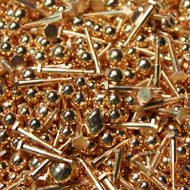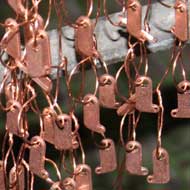Copper Plating For Excellent Electrical & Thermal Conductivity & Adhesion
What Is Copper Plating?
Copper plating is the process of electrolytically depositing a layer of copper. Copper does, however, readily oxidize, so copper plated parts that are intended to be decorative are often lacquered after plating to retain a bright and shiny appearance.
Excellent Electrical And Thermal Conductivity
Copper is utilized in electronic components and equipment because of its excellent electrical and thermal conductivity as well as its relatively low cost.
About Copper Electroplating Baths
Copper electroplating baths fall into three general categories:
- Highly alkaline baths that are primarily cyanide based.
- Mildly alkaline baths that are usually pyrophosphate based.
- Acid baths that are typically sulfate or fluoroborate based.
Choosing Which Plated Copper Bath To Use
The choice of which copper plating bath to use is dependent upon many factors, deposition rate, operating current density range over which superior deposits can be obtained, throwing power and resultant grain size being some properties that affect the choice. All types of copper electroplating baths require additives to achieve the desired results.
Alkaline Cyanide Baths For Plating Steel & Zinc
Alkaline cyanide baths are the most widely used formulations because of their overall greater throwing power and ability to plate steel and zinc components without worrying about an inferior immersion copper deposition occurring.
Mild Alkaline Pyrophosphate Baths For Circuit Boards
Mild alkaline pyrophosphate baths have found widespread use in the plating of circuit boards where the same thickness of copper can be deposited on the walls of a through hole as on the surface. Pyrophosphate bath rinses waters are less corrosive than acid baths and are easier to waste treat than any other copper plating process.
Acid Baths For Decorative Purposes
Acid baths are generally used for decorative purposes because they can produce very bright as-deposited results. The plated parts are then lacquered or clear coated to prevent oxidation. Acid baths are also used for plating plastic parts and for plating circuit boards at high speeds.
Plated Copper As A Base Layer
When the base material of a to-be-plated part isn't suitable for plating or hot dipping, copper is often used as the base plate. This process is also called underplating. Electroplating a base metal with copper:
-
Improves Final Finish
Copper deposits are less likely to have pinholes or other defects, resulting in an improved final finish. -
Improves Adhesion
As a base layer under nickel or chromium, copper plating improves adhesion of the final deposit to the part. -
Adheres To Aluminum
Copper provides an especially good undercoat for aluminum parts, because most other metal deposits will simply not adhere to aluminum.
Copper Plating Specifications
Hi-Tech Plating ensures the highest quality results by plating copper in accordance with MIL-C-14550 and ASTM-B-734 specifications and by being ISO9000 and NADCAP certified.
Contact Hi-Tech Plating
Hi-Tech Plating will work with you to ensure that the right type of plating is selected for your application. Put our expertise - and our top quality and service - to work for you today.


